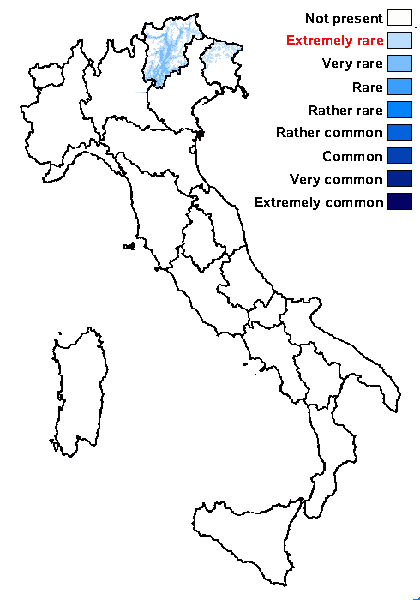Verrucaria vicinalis Arnold
Verh. zool.-bot. Ges. Wien, 29: 377, 1879.
Synonyms:
Distribution: N - Frl (Breuss 2008), TAA (Breuss 2008b, Nascimbene & al. 2022).
Description: Thallus crustose, endosubstratic, whitish, smooth, delimited from conspecific thalli by brown lines, the whole forming a clear mosaic. Perithecia black, immersed in the rock, with only the black apex visible, 0.2-0.3 μm across, forming shallow pits in the rock. Involucrellum reaching down to 2/3 of the perithecium; exciple at first colourless, then brown; hamathecium of periphyses and periphysoids, interascal filaments absent; hymenial gel hemiamyloid, I+ red (I+ blue at very low concentrations of I), K/I+ blue. Asci 8-spored, clavate, I-, fissitunicate, the wall thickened above, with an ocular chamber, dehiscent by extrusion of an endotunica to form a delicate rostrum, Verrucaria-type. Ascospores 1-celled, hyaline, ellipsoid, 12-16 x 6-7 μm. Photobiont chlorococcoid. Spot tests: K-, C-, KC-, P-, UV-. Chemistry: without lichen substances.Note: a species of calcareous rocks, known from South Tyrol, the Carpathians and a few localities in the Alps and the Pyrenees, which needs further study; the record from Liguria (Nimis 1993: 750), being especially dubious, is not accepted here. For further details see Breuss (2008, 2008b).
Growth form: Crustose endolithic
Substrata: rocks
Photobiont: green algae other than Trentepohlia
Reproductive strategy: mainly sexual
Poorly known taxon in need of further study
Commonnes-rarity: (info)
Alpine belt: absent
Subalpine belt: absent
Oromediterranean belt: absent
Montane belt: extremely rare
Submediterranean belt: very rare
Padanian area: absent
Humid submediterranean belt: absent
Humid mediterranean belt: absent
Dry mediterranean belt: absent

Predictive model
Growth form: Crustose endolithic
Substrata: rocks
Photobiont: green algae other than Trentepohlia
Reproductive strategy: mainly sexual
Poorly known taxon in need of further study
Commonnes-rarity: (info)
Alpine belt: absent
Subalpine belt: absent
Oromediterranean belt: absent
Montane belt: extremely rare
Submediterranean belt: very rare
Padanian area: absent
Humid submediterranean belt: absent
Humid mediterranean belt: absent
Dry mediterranean belt: absent

Predictive model
 INDEX FUNGORUM
INDEX FUNGORUM
 GBIF
GBIF
 DOLICHENS
DOLICHENS


